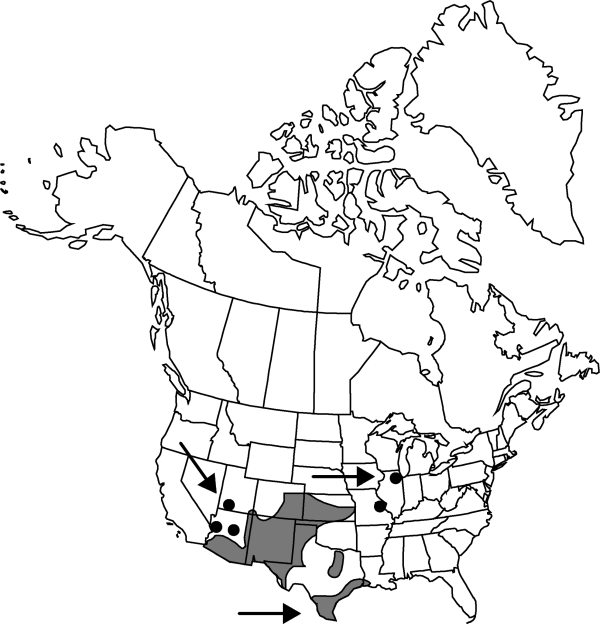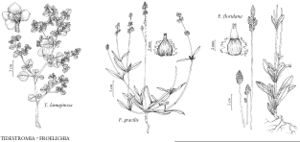Tidestromia lanuginosa
J. Wash. Acad. Sci. 6: 70. 1916.
Herbs, annual, yellowish green to gray-green or rarely reddish, to 50 cm, canescent, lanuginose, or glabrous; trichomes completely candelabriform. Stems ascending, decumbent, or prostrate, herbaceous, buds absent on stem bases. Leaves: petiole to 2.5 cm; blade gray-green, widely obovate, ovate-trullate, circular, or lanceolate, 0.8–3.2 × 0.9–3 cm, chartaceous to fleshy, base attenuate or oblique. Inflorescences 1–3-flowered; involucral leaf petiole to 0.6 cm, blade ovate, obovate, lanceolate, or transversely elliptic, 0.3–4 × 0.2–3.1 cm, chartaceous to fleshy, base attenuate or oblique, apex acute to obtuse; involucres on secondary branches formed by connation of involucral leaf petioles, which become indurate and adnate with stems or with leaf petiole and stems; bracts widely ovate, 1–1.6 × 0.8–1 mm, apex obtuse, distinctly lanuginose; bracteoles 1–1.5 × 0.6–0.8 mm, apex obtuse, distinctly lanuginose distally. Flowers 1.5–3 mm; tepals yellowish, 1.1–3 × 0.7–1.2 mm, glabrous or lanuginose; staminal cup 0.5–1 mm; filaments 0.5–1.4 mm; anthers 0.7–1.1 mm; pseudostaminodes absent or short-triangular lobes, 0.2 mm; ovary 0.3–0.8 × 0.5–0.7 mm; style to 0.1 mm; stigmas 0.1–0.3 mm. Utricles 1.3–1.6 × 1–1.3 mm. Seeds brown-red, 1.1–1.4 × 0.7–1.2 mm.
Phenology: Flowering spring–fall or late winter–fall.
Habitat: Primary and disturbed vegetation, riparian forests, pinyon-juniper woodlands, desert scrub, creosote bush scrub, mesquite-yucca communities, grasslands, coastal dunes, beaches, roadsides, fields, in basalt deposits, limestone, gypseous, calcareous, alluvial, rocky, volcanic, gravelly, sandy, silty, muddy, and clayey soils
Elevation: 0-2100 m
Distribution

Ariz., Calif., Colo., Ill., Kans., La., Mo., N.Mex., Okla., Tex., Utah, Mexico (Baja California, Chihuahua, Coahuila, Durango, Nuevo León, San Luis Potosí, Sinaloa, Sonora, Tamaulipas, Zacatecas), West Indies (Dominican Republic).
Discussion
Tidestromia lanuginosa shows wide variation; two subspecies can be recognized primarily on the basis of pollen and trichome features (I. Sánchez del Pino and H. Flores Olvera 2002). The trichomes are typically candelabriform with more or less regular branches. In some parts of the plants, the terminal cells of the trichomes have a much greater number of irregular and enlarged branches. The distribution of secondary branches has taxonomic importance if infrataxa are recognized: subsp. lanuginosa has trichomes with the terminal cell projections irregular only; subsp. eliassoniana has trichomes with the terminal cell projections either irregular or spreading (I. Sánchez del Pino and H. Flores Olvera 2002). Subspecies lanuginosa flowers over a longer season than subsp. eliassoniana, and it occurs from central United States to northern Mexico and the West Indies, whereas subsp. eliassoniana occurs from southwestern United States to northwestern Mexico.
Selected References
None.
